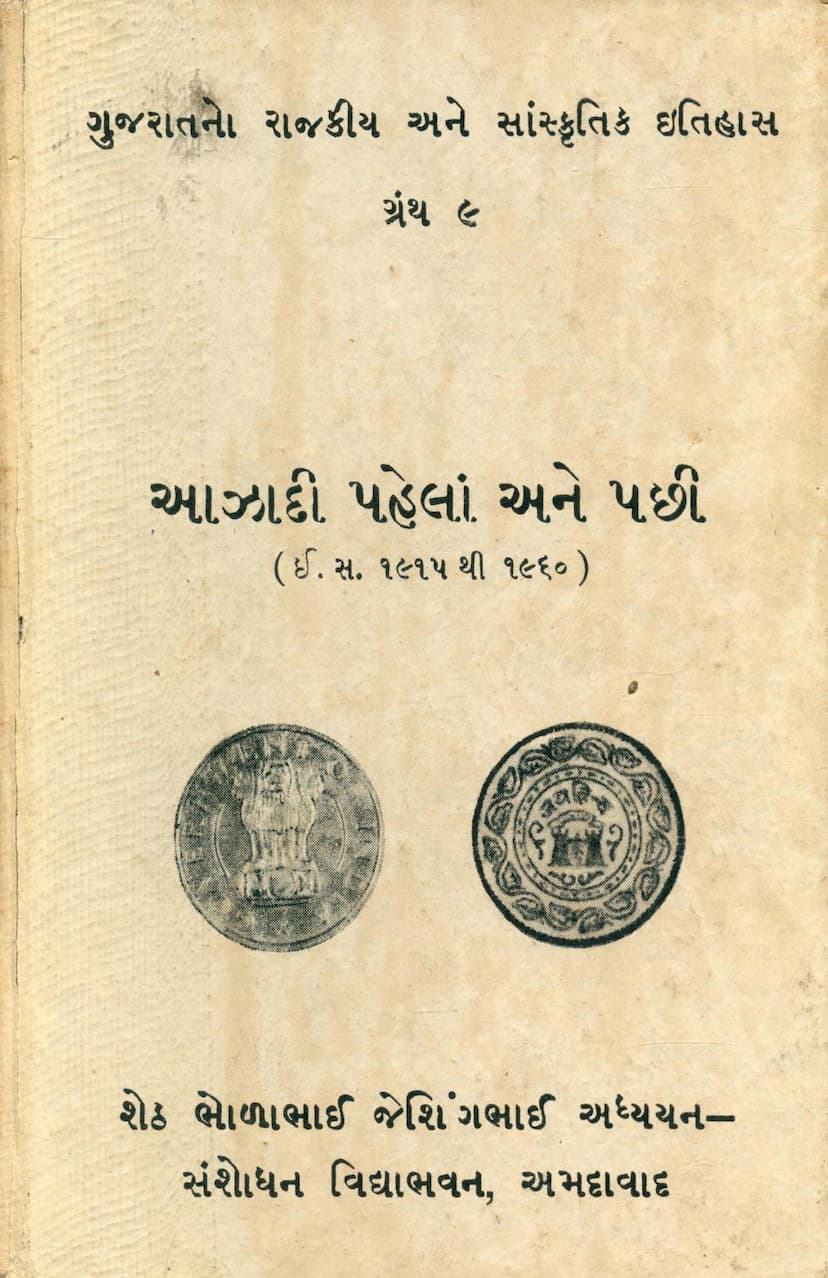Gujaratno Rajkiya Ane Sanskritik Itihas Part 09 Azadi Pahela Ane Pachi
Added to library: September 1, 2025

Summary
This is a comprehensive summary of the Jain text provided, focusing on the historical and cultural aspects of Gujarat from 1915 to 1960, covering the period before and after India's independence.
Book Title: Gujaratno Rajkiya ane Sanskritik Itihas Part 09 Azadi Pahela ane Pachi (Political and Cultural History of Gujarat Part 09: Before and After Independence) Author(s): Hariprasad G Shastri, Pravinchanca Chimanlal Parikh Publisher: B J Adhyayan Sanshodhan Vidyabhavan, Ahmedabad Catalog link: https://jainqq.org/explore/032612/1
This book, Volume 9 of the illustrated series on the political and cultural history of Gujarat, covers the crucial period from 1915 to 1960, encompassing India's struggle for independence and the formative years of the independent state of Gujarat.
Overall Scope:
The series aims to present a comprehensive political and cultural history of Gujarat from its prehistoric periods up to the formation of the Gujarat state in 1960. This particular volume, Volume 9, focuses on the modern era, divided into two main phases:
- Pre-Independence (1915-1947): The period leading up to India's independence, marked by the Indian independence movement and Gujarat's significant contribution to it.
- Post-Independence (1947-1960): The era after independence, focusing on the integration of princely states, the development of the Bombay state, and ultimately the formation of Gujarat state.
The book is structured into four main sections (Sections 1-4), each covering specific aspects of Gujarat's history during this period. It also includes several appendices that delve into specialized topics.
Key Themes and Content:
Section 1: Preliminary (Prastavik)
- Chapter 1: Source Materials (Sadhan-Samagri): This chapter details the various sources used to reconstruct this period of history. It includes:
- Government records and correspondence
- Census reports
- Gazetteers
- Contemporary historical writings
- Newspapers and periodicals
- Literary works useful for history
- Archaeological activities and museums
Section 2: Political History (Rajkiya Itihas)
- Chapter 2 & 3: Political Awakening in British India (1915-1947): These chapters cover the rise of political consciousness, the role of political parties, constructive activities, and the history of princely states up to 1947. It highlights Gujarat's significant contribution to the national freedom struggle, recognizing Mahatma Gandhi as the "Father of the Nation" and Sardar Patel as the architect of national unity through the integration of princely states.
- Chapter 4: Princely States (1914-1947): This chapter details the history of the princely states in Gujarat during the period, their administrative structures, and their role in the broader political landscape.
- Chapter 5: Political History (1947-1960): This section outlines the political history of Gujarat in the post-independence era, leading up to the formation of Gujarat state.
- Chapter 6: State Administration: This chapter examines the administrative systems under British rule and in the princely states until 1947, and the changes that occurred from 1947 to 1960. It also includes an appendix on the coins of the British Raj, princely states, and the Republic of India.
Section 3: Cultural History (Sanskrutik Itihas)
- Chapter 7: Social Conditions: This chapter discusses the progress of the Dalit communities, social reforms, and various social activities undertaken during this period.
- Chapter 8: Economic Conditions and Development: This chapter reviews the progress in agriculture, trade, ports, transportation, banking, insurance, and various industries. An appendix provides information on Gujaratis living in other regions of India and abroad.
- Chapter 9: Education: This chapter analyzes the development of primary, secondary, and higher education both before and after independence. It highlights activities in pre-primary education, such as kindergarten and Montessori methods, and includes an appendix on the development of library services.
- Chapter 10: Literature: This chapter discusses new trends and perspectives in literature, the translation of works from other languages into Gujarati, and literary creation in other languages within Gujarat. An appendix introduces significant literary institutions.
- Chapter 11: Religious Conditions: This chapter surveys various religious sects, saints, devotees, religious institutions, and new religious philosophies.
- Section 4: Arts (Kalao)
- Chapter 12: Fine Arts (Lalit Kalao): This section covers painting, music, Garba, Raas, dance, drama, and other fine arts, along with related institutions.
- Chapter 13: Architecture, Sculpture, Crafts, and Folk Arts: This section provides an introduction to architecture, sculpture, handicrafts, and folk arts.
Key Appendices and Additional Information:
- Appendix 1: New Political Parties: Discusses the emergence of new political parties during this period.
- Appendix 2: Constructive Activities: Details various nation-building and social upliftment activities.
- Appendix 3: Coins: A brief introduction to the coins of the British Raj, princely states, and the Republic of India.
- Genealogies (Vanshavalio): Provides genealogical information of important royal dynasties from the Maratha period to the integration of princely states.
- Lists: Includes lists of references, a glossary of special terms, and a list of illustrations.
- Maps and Photographs: The book is enriched with maps illustrating the political and cultural landscape of Gujarat, along with photographs of significant individuals, monuments, sculptures, art, and crafts.
Methodology and Editorial Approach:
The work is not attributed to a single author but is a compilation by various subject experts. The editors have taken care to ensure consistency in page numbering, reference citations, and the inclusion of detailed bibliographies and glossaries, supported by relevant diagrams and photographs. The authors emphasize the importance of this period in shaping modern Gujarat, highlighting the dual efforts for independence and the establishment of the state.
Publisher and Financial Support:
The publication was made possible by a grant of 75% from the Gujarat State Government, with the Seth Bholabhai Jesinghbhai Adhyayan-Sanshodhan Vidyabhavan playing a pivotal role in its conception and execution.
Overall Significance:
This volume is a valuable contribution to understanding the political and cultural transformation of Gujarat during a period of immense change, from the pre-independence struggle to the formation of the modern state. It provides a detailed account of the key events, personalities, and societal developments that shaped Gujarat.